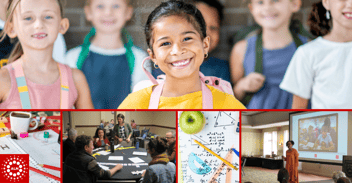
MTSS and the All Learners Lesson Structure
Schools and classrooms are filled with diverse learners who all have their own individual knowledge and needs when it comes to learning. A Multi-Tiered or Multi-Layered System of Support (MTSS) provides a system in which educators can meet the needs of all students through adding layers of support.
All Learners Network's (ALN) All Learners Lesson Structure provides a way to incorporate the elements of MTSS within a math class/block. The All Learners Lesson Structure includes four elements: Launch, Main Lesson, Math Menu and Closure. All parts of the lesson include differentiation, inclusion for all learners and opportunities for students to engage in developing conceptual understanding (Common Core State Standards) alongside development of mathematical practices (Standards for Mathematical Practices). Here are some ways each component of the lesson supports a Multi-Layered System of Support:
Launch
Beginning a math block with a number sense routine engages students with math concepts, it activates prior knowledge and prepares students to engage more deeply with mathematical ideas. Students learn from their peers, are exposed to different strategies and approaches to problems, and discuss similarities and differences among strategies. Number sense routines are “low floor, high ceiling,” so everyone has a way to engage with the task using their knowledge base. Additionally, through careful planning scaffolds can be used for students to increase engagement with a launch. This scaffolding might include previewing a task and having additional think time, it might be using a tool to support or record thinking, a partner conversation could provide a way to engage.
Main Lesson
During the Main Lesson all students are engaged with grade level math content. Differentiation is done through scaffolding, task development and questioning. Low floor, high ceiling tasks are a great way to ensure all students have an entry into math learning, and can push their individual thinking. Scaffolding can support access to grade level content and strategic questioning can support students in exploring and representing mathematical ideas.
Knowledge of your students and assessments, formative or summative, can inform the movement of the main lesson and determine when the class as a whole needs more focus in core instruction around a particular topic. If over 80% of the class has understanding then individuals or a small group would need more focus on the topic. Collaboration with colleagues can provide educators with resources to reteach or reinforce concepts in a different way.
Math Menu
In the Math Menu portion of the lesson students are engaged in practice, “just right math” and reflection while teachers provide focused small group instruction.
The elements of Math Menu typically include: window panes, games, journals and problem solvers. The window panes provide spaced practice of math skills. The games reinforce and support development of strategies. Math journals provide a space for reflection or observations around math ideas and learning. The problem solvers challenge thinking and integration of math knowledge in a variety of problems and non-curricular tasks. All of these elements have aspects of choice so students can select the problem or task they feel ready to take on and self-challenge. It provides options to have a particular task to be required, a “must do”, while also providing students opportunities to take control and make choices for their own learning from a collection of differentiated tasks. Math Menus are designed with students in mind using evidence from student work and formative assessments, which may include work from prior menus.
Teacher stations provide the opportunity for additional layers (Tier 2 or 3) of instruction to occur, providing targeted instruction that will be developed using data from student work, observations and formative assessments. This instruction will support students in growing their understanding of High Leverage Concepts (HLCs). As progress monitoring occurs, these intervention groups change and respond to students' needs.
Closure
During this part of the lesson big mathematical ideas are noted, students engage in reflection on their work and the understanding they are growing around concepts. Explicitly discussing connections among mathematical ideas and concepts, and relating new learning to prior knowledge, is essential for some learners to support understanding they might not see as related. Again this is a time when all students can learn from each other.
As the planning occurs for lessons it is important to remember that data is used in making decisions. Considering the needs of the whole class, small groups and individuals and using that information to make choices about tasks for Launch, Main Lesson and Math Menus can enhance learning for everyone. This continuous cycle of teaching, monitoring progress, responding through the four components of the All Learners Lesson Structure, and collaboration repeat in making instructional decisions.




%20(17).png?width=352&name=Hero%20Images%20(WebsiteBlogEmails)%20(17).png)
%20(20).png?width=352&name=Hero%20Images%20(WebsiteBlogEmails)%20(20).png)